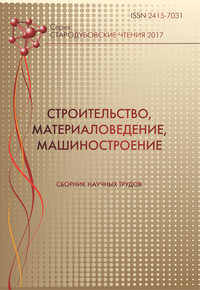Interfacial processes during infiltration of the quasicrystal-reinforced composites
Keywords:
macroheterogeneous composite material, quasicrystal filler, furnace infiltration, dissolution, interfacial zone, average geometric vibration frequency, heat capacityAbstract
Abstract. Purpose. The application of quasicrystals as fillers of composites allows reserving their unique physical-andmechanical properties and averting the limitations connected with their enhanced brittleness. The development of the composition and technology to fabricate composites demands experimental and theoretical investigation of the peculiarities in the structure and properties formation of the interfacial zones between the filler and binder. Methodology. Macroheterogeneous composites reinforced by Al–Co–Cu or Al–Co–Ni quasicrystal fillers were infiltrated at 1100 К during 30 minutes. Л62 brass was used as metallic binder. The structure of the composites was investigated by metallographic, X-ray, and energy dispersive X-ray analyses. To control structural and phase composition of interfacial zones appearing between the filler and binder during infiltration an original method of statistical structural analysis was applied. Findings. The structure and properties of interfacial zones between the filler and solidified binder were investigated. The two- and three-dimensional graphic models of the interfacial zones were suggested. The peculiarities in composites structure formation were explained by prevailing dissolution of filler crystal phases in the molten binder during infiltration. The dissolution rates of quasicrystal and crystal phases differed due to reduced average geometric atom vibration frequency of quasicrystals caused by their excess heat capacity. Originality. The compositions and furnace infiltration technology to produce brass-based composites reinforced by Al–Co–Cu or Al–Co–Ni quasicrystal fillers were suggested. The peculiarities in the structure formation of the interfacial zones between the filler and binder were investigated. The average geometric atom vibration frequency for quasicrystals were calculated. The dependency of this characteristic on the dissolution rate of filler solid phases in the molten binder was shown. The lower atom vibration frequency of quasicrystals was explained by their excess heat capacity. Practical value. The developed macroheterogeneous composites reinforced by Al–Co–Cu or Al–Co–Ni quasicrystal fillers can be recommended as coatings to protect surface of automobile transport parts working under dry friction or corrosive media.References
Bashev V. F. Makrogeterogennye kompozicionnye materialy na osnove kvazikristallicheskogo splava Al65Co20Cu15 / V. F. Bashev, E. V. Sukhovayа, Yu. V. Syrovatko // Sbornik nauchnykh trudov «Stroitel'stvo, materialovedenie, mashinostroenie». – 2015. – № 80. – S.32-37.
Bashev V. F. Statisticheskiy analiz mikrostruktury kompozicionnykh materialov / V. F. Bashev, E. V. Sukhovayа, Yu. V. Syrovatko // Sbornik nauchnykh trudov «Stroitel'stvo, materialovedenie, mashinostroenie». – 2012. – № 64. – S.53-57.
Kittel' Ch. Vvedenie v fiziku tverdogo tela / Ch. Kittel'.- Moskva: Nauka, 1978. – 791 s.
Landau L. D. Statisticheskayа fizika / L. D. Landau, E. M. Lifshic. – Moskva: Nauka, 1976. – 583 s.
Prekul A. F. Vysokotemperaturnayа teployemkost' kvazikristalla Al63Cu25Fe12 / A. F. Prekul, V. A. Kazancev, N. I. Shchegolikhina, R. I. Gulyаeva, K. Edagawa // Fizika tverdogo tela. – 2008. – T.50, № 11. – S. 1933-1935.
Prekul A. F. Kalorimetricheskoe issledovanie еlektronnykh i reshetochnykh vozbuzhdeniy ikosaеdricheskogo kvazikristalla v oblasti umerennykh temperatur / A. F. Prekul, E. V. Shapovalova, N. I. Shchegolikhina // Fizika tverdogo tela. – 2010. – T.52, № 9. – S.1675-1680.
Prekul A. F. Sravnitel'noe issledovanie teploemkosti ikosaеdricheskikh kvazikristallov v tverdom i zhidkom sostoyаniyаkh / A. F. Prekul, N. I. Shchegolikhina, A. B. Gaiduchenko, K. I. Grushevskiy // Fizika tverdogo tela. – 2011. – T.53, № 10. – S.18851888.
Sukhovayа E. V. Zakonomernosti strukturoobrazovaniyа mezhfaznykh granic razdela v kompozicionnykh materialakh / E. V. Sukhovayа, Yu. V. Syrovatko // Vіsnik Shіdnoukrains'kogo nacіonal'nogo unіversitetu іm. V.Dalyа. – 2011. – № 8(162), Ch.2. – S. 177-184.
Sukhovayа E. V. Strukturoobrazovanie granic razdela v kompozicionnykh materialakh, armirovannykh kvazikristallicheskim splavom-napolnitelem Al–Co–Cu / E. V. Sukhovayа, Yu. V. Syrovatko // Adgeziyа rasplavov i paika materialov. – 2014. – № 47. – S.58-65.
Syrovatko Yu. V. Strukturoobrazovanie kompozicionnykh materialov, uprochnennykh kvazikristallami / Yu. V. Syrovatko, E. V. Sukhovayа // Vіsnik Dnіpropetrovs'kogo unіversitetu. Raketno-kosmіchna tekhnіka. – 2013. – T.21, № 4. – S.113-121.
Sukhova O. V. Metal matrix composites reinforced with Al–Co–Cu particles / O. V. Sukhova, Yu. V. Syrovatko // Vіsnik Dnіpropetrovs'kogo unіversitetu. Fіzika. Radіoelektronіka. – 2016. – T.24, № 23. – S.53-58.
Downloads
Published
Issue
Section
License
Редакція Видання категорично засуджує прояви плагіату в статтях та вживає всіх можливих заходів для його недопущення. Плагіат розглядається як форма порушення авторських прав і наукової етики.
При виявлені у статті більш ніж 25% запозиченого тексту без відповідних посилань та використання лапок, стаття кваліфікується як така, що містить плагіат. У цьому випадку стаття більше не розглядається редакцією, а автор отримує перше попередження.
Автори, в статтях яких повторно виявлено плагіат, не зможуть публікуватися в усіх журналах Видавництва ДВНЗ «Придніпровська державна академія будівництва та архітектури».
Автори, які публікуються у цьому журналі, погоджуються з наступними умовами:
- Автори залишають за собою право на авторство своєї роботи та передають журналу право першої публікації цієї роботи на умовах ліцензії Creative Commons Attribution License, котра дозволяє іншим особам вільно розповсюджувати опубліковану роботу з обов'язковим посиланням на авторів оригінальної роботи та першу публікацію роботи у цьому журналі.
- Автори мають право укладати самостійні додаткові угоди щодо неексклюзивного розповсюдження роботи у тому вигляді, в якому вона була опублікована цим журналом (наприклад, розміщувати роботу в електронному сховищі установи або публікувати у складі монографії), за умови збереження посилання на першу публікацію роботи у цьому журналі.
- Політика журналу дозволяє і заохочує розміщення авторами в мережі Інтернет (наприклад, у сховищах установ або на особистих веб-сайтах) рукопису роботи, як до подання цього рукопису до редакції, так і під час його редакційного опрацювання, оскільки це сприяє виникненню продуктивної наукової дискусії та позитивно позначається на оперативності та динаміці цитування опублікованої роботи (див. The Effect of Open Access).

